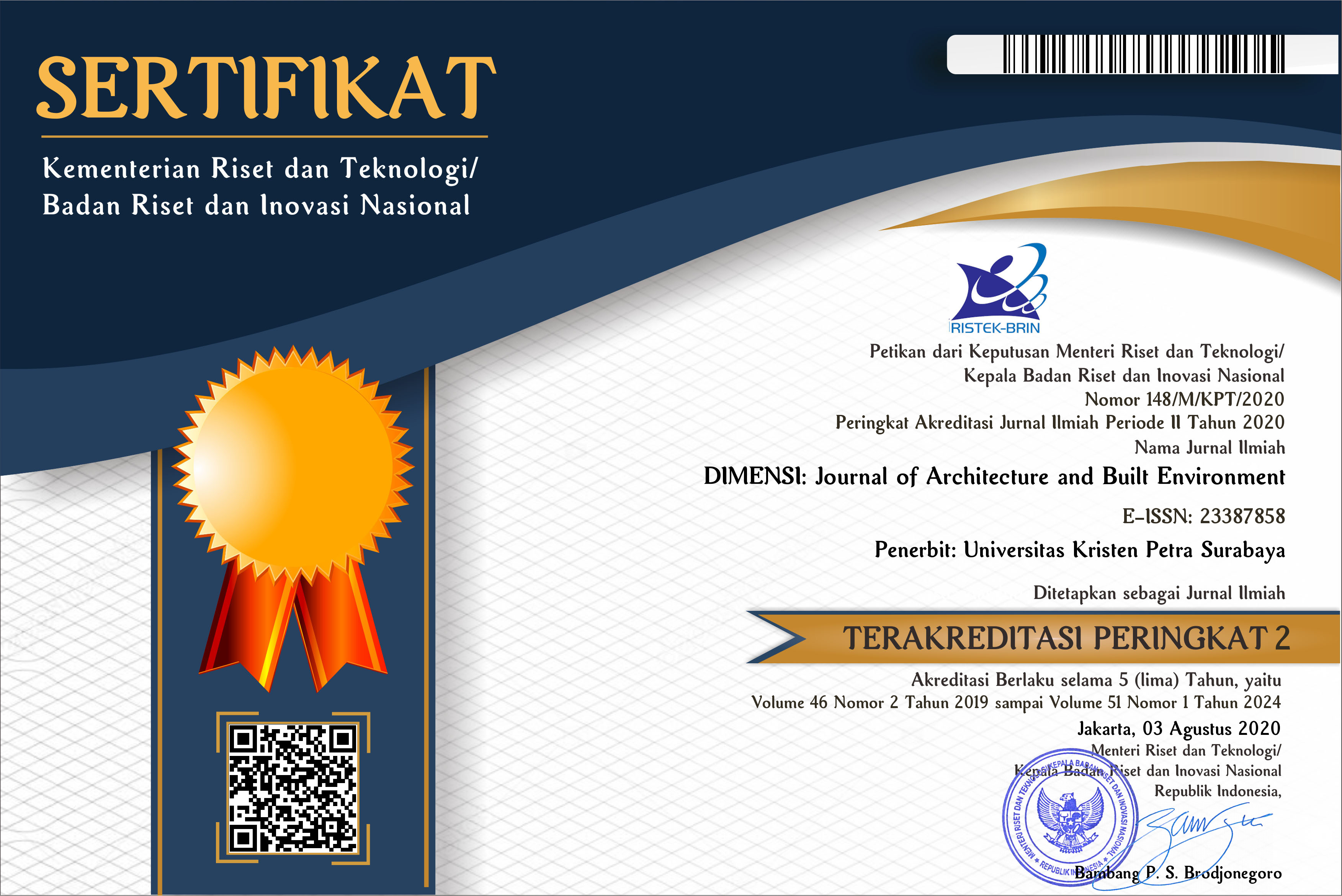ACCELERATING LOW-COST HOUSING CONSTRUCTION IN INDONESIA: LESSON LEARNED FROM KAMPONG NAGA
 :
:
https://doi.org/10.9744/dimensi.44.1.79-86
Keywords:
Local indigenous, local prefabrication, sustainable development, low-cost housing.Abstract
Construction methods used in housing development in Indonesia cannot follow the raise in housing needs. Thus, Indonesia is facing a housing backlog up to millions of houses. Prefabricated construction method is one of the solutions that can accelerate housing development. This method has actually been used by some of traditional villages in Indonesia such as Kampong Naga, in West Java. Learning from its local wisdom, this research analyses the traditional prefabricated construction of Kampong Naga as an input for the development of housing development in Indonesia. Qualitative method is used through an observation to the house construction method in Kampong Naga. The result shows that traditional houses in Kampong Naga has a high level of prefabrication, and sustainable in material selection as well as in construction techniques. It is also found that there is an effort from the villagers to expand their prefabricated method to the community outside their village. Regarding to the research results, the local indigenous prefabricated system of Kampong Naga could be considered as a solution for the low cost housing development in Indonesia.
Downloads
References
Anderson, M. & Anderson, P. (2007). Prefab Prototypes: Site Specific Design for Offsite Construction, Princeton Architectural Press. New York.
Akhmad, A.G. et al. (2008). Disain Rumah Tinggal Konstruksi “Knock Down” (Tinjauan Khusus Penggunaan Prefabrikasi Lokal). Jurnal SMARTek, 6(1), pp.18 – 28.
Amalia, A. (2008). Prafabrikasi, antara Arsitektur, Teknologi, dan Sosial Ekonomi. Skripsi. Teknik Arsitektur Fakultas Teknik Universitas Indonesia.
Brock, L. & Brown, J. (2011). The Prefabricated House in the Twenty-First Century: What Can We Learn from Japan? A Case Study of the KST-Hokkaido House. URL: http://timber.ce. wsu. edu/Resources/papers/4-2-3.pdf
Davidson, C. (2008). Myths and Realities of Prefabrication for Post Disaster Reconstruction. Journal I Rec Building resilience achieving effective post-disaster reconstruction.
McGraw- Hill Construction (2011). Prefabrication and Modularization, Increasing Productivity in Construction industry. Smart Market Report.
Olivia, D. (2008). Studi Desain Dinding Prefabrikasi Rumah Massal Dari Aspek Kecepatan Membangun. Tesis. Institut Teknologi Bandung.
Rippon, J. (2011). The Benefits and Limitations of Prefabricated Home Manufacturing in North America, a Report Submitted in Fulfillment of the Requirements for the Degree of Bachelor of Science in The Faculty of Forestry April 11.
Utami, M.N. et. al. (2014). Kajian Sustainable Material Bambu, Batu, Ijuk dan Kayu pada Bangunan Rumah Adat Kampong Naga. Jurnal Reka Karsa, 2 (2).
Zuraida, S., Larasati, D. & Wdyowijatnoko, A. (2015). Life Cycle Assessment of Sustainable Housing Material: The Case of Bambo, The Second HabiTechno International Conference Institut Teknologi Bandung, 11 November 2015 Bandung, Indonesia
Larasati, D., Primasetra, A., Victoria, P. & Fadhly, F.A.R. (2015). Development of Community-Based Prefabricated Housing Industry to Increase Public Participation in the Fulfillment of Housing Demand. 1st International Conference on Rural Development and Community Empowerment, Institut Teknologi Bandung, Sumedang, Indonesia.
Downloads
Published
How to Cite
Issue
Section
License
Authors who publish with this journal agree to the following terms:
- Authors retain copyright and grant the journal right of first publication with the work simultaneously licensed under a Creative Commons Attribution License that allows others to share the work with an acknowledgement of the work's authorship and initial publication in this journal.
- Authors are able to enter into separate, additional contractual arrangements for the non-exclusive distribution of the journal's published version of the work (e.g., post it to an institutional repository or publish it in a book), with an acknowledgement of its initial publication in this journal.
- Authors are permitted and encouraged to post their work online (e.g., in institutional repositories or on their website) prior to and during the submission process, as it can lead to productive exchanges, as well as earlier and greater citation of published work (See The Effect of Open Access).


















